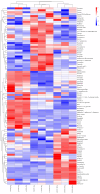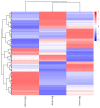Integrated Analyses of Metabolome and RNA-seq Data Revealing Flower Color Variation in Ornamental Rhododendron simsii Planchon
- PMID: 39202401
- PMCID: PMC11353987
- DOI: 10.3390/genes15081041
Integrated Analyses of Metabolome and RNA-seq Data Revealing Flower Color Variation in Ornamental Rhododendron simsii Planchon
Abstract
Rhododendron simsii Planchon is an important ornamental species in the northern hemisphere. Flower color is an important objective of Rhododendron breeding programs. However, information on anthocyanin synthesis in R. simsii is limited. In this research, the regulatory mechanism of anthocyanin biosynthesis in R. simsii was performed through the integrated analysis of metabolome and RNA-seq. A total of 805 and 513 metabolites were screened by positive and negative ionization modes, respectively, In total, 79 flavonoids contained seven anthocyanidins, 42 flavanones, 10 flavans, 13 flavones, and seven flavonols. Methylated and glycosylated derivatives took up the most. Differentially accumulated metabolites were mainly involved in "flavone and flavonol biosynthesis", "cyanoamino acid metabolism", "pyrimidine metabolism", and "phenylalanine metabolism" pathways. For flavonoid biosynthesis, different expression of shikimate O-hydroxycinnamoyltransferase, caffeoyl-CoA O-methyltransferase, flavonoid 3'-monooxygenase, flavonol synthase, dihydroflavonol 4-reductase/flavanone 4-reductase, F3'5'H, chalcone synthase, leucoanthocyanidin reductase, and 5-O-(4-coumaroyl)-D-quinate 3'-monooxygenase genes ultimately led to different accumulations of quercetin, myricetin, cyanidin, and eriodictyol. In flavone and flavonol biosynthesis pathway, differential expression of F3'5'H, flavonoid 3'-monooxygenase and flavonol-3-O-glucoside/galactoside glucosyltransferase genes led to the differential accumulation of quercetin, isovitexin, and laricitrin. This research will provide a biochemical basis for further modification of flower color and genetic breeding in R. simsii and related Rhododendron species.
Keywords: Rhododendron simsii Planchon; anthocyanins; flower color breeding; flower color variation; molecular mechanism.
Conflict of interest statement
The authors declare no conflict of interest.
Figures









References
-
- Xu J., Zhang L., Zhao B., Shen H. Assessment of genetic diversity among six populations of Rhododendron triflorum in Tibet using ISSR and AFLP markers. S. Afr. J. Bot. 2017;108:175–183. doi: 10.1016/j.sajb.2016.10.023. - DOI
-
- Hahn C.Z., Michalski S.G., Durka W. Gene flow in, and mating system of Rhododendron simsii in a nature reserve in subtropical china. Nord. J. Bot. 2016;35:1–7. doi: 10.1111/njb.01311. - DOI
-
- Wang S., Jin Z., Luo Y., Li Z., Fang Y., Xiang J., Jin W. Genetic diversity and population structure of Rhododendron simsii Planch. (Ericaceae) populations based on microsatellite markers. Nord. J. Bot. 2019;39:1–10. doi: 10.1111/njb.02251. - DOI
-
- De Loose R. The flower pigments of the Belgian hybrids of Rhododendron simsii and other species and varieties from Rhododendron subseries obtusum. Phytochemistry. 1969;8:253–259. doi: 10.1016/S0031-9422(00)85822-7. - DOI
MeSH terms
Substances
Grants and funding
LinkOut - more resources
Full Text Sources
Miscellaneous

